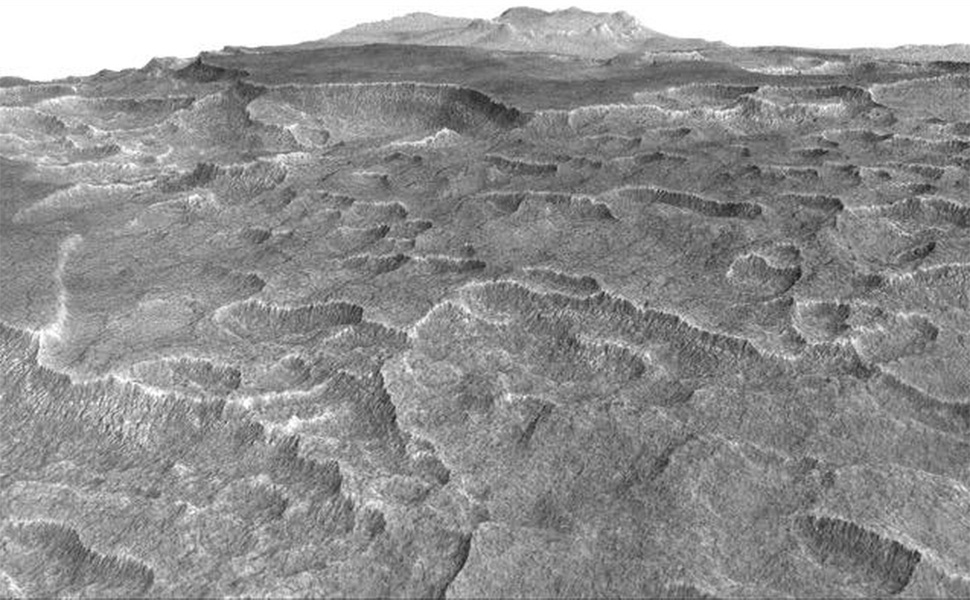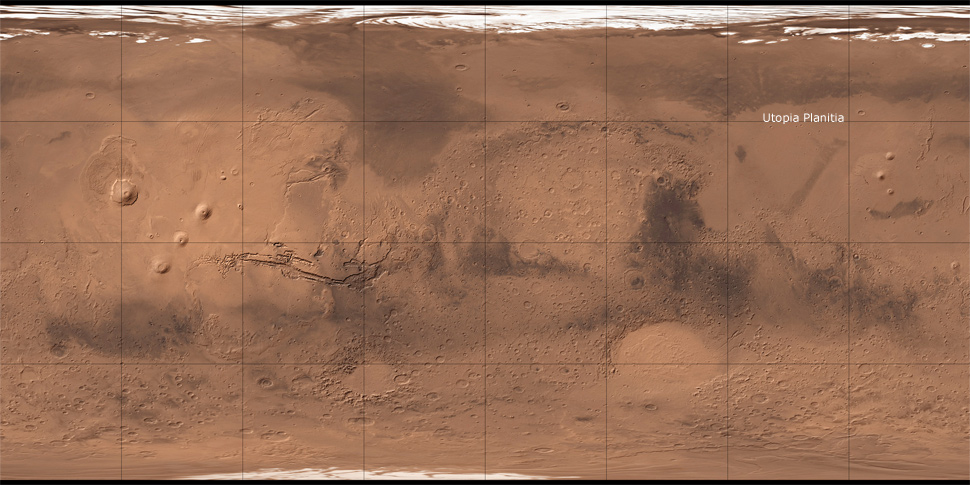
24th November 2016 Huge deposit of water ice found below surface of Mars NASA reports that its Mars Reconnaissance Orbiter has found a huge deposit of water ice just under the surface of the planet Mars, in the region known as Utopia Planitia.
Frozen beneath a region of cracked and pitted plains on Mars lies a volume of water equivalent to Lake Superior, the largest of the Great Lakes, researchers using NASA's Mars Reconnaissance Orbiter have determined. Scientists examined part of Mars' Utopia Planitia region, in the mid-northern latitudes, which forms part of the largest recognised impact basin on Mars and in the Solar System with an estimated diameter of 3300 km. It is also where the Viking 2 lander made its historic touchdown in September 1976. The Mars Reconnaissance Orbiter's ground-penetrating Shallow Radar (SHARAD) instrument was used to record data from over 600 overhead passes, revealing a deposit more extensive in area than the state of New Mexico. The water ice ranges in thickness from about 80 metres (260 feet) to about 170 metres (560 feet) with a composition that is 50 to 85 percent water ice, mixed with dust or larger rocky particles. At the latitude of this deposit, halfway from the equator to the pole, water ice cannot persist on the surface today. It sublimes into water vapour in the planet's thin, dry atmosphere. The Utopia deposit is shielded from the atmosphere by a soil covering estimated to be 1 to 10 metres (3 to 33 feet) thick.
Click to enlarge
"This deposit probably formed as snowfall accumulating into an ice sheet mixed with dust, during a period in Mars history when the planet's axis was more tilted than it is today," said Cassie Stuurman of the Institute for Geophysics at the University of Texas, Austin. She is the lead author of a report in the journal Geophysical Research Letters. The name Utopia Planitia translates as the "plains of paradise." The newly surveyed ice deposit represents less than one percent of all known water ice on Mars – but it more than doubles the volume of thick, buried ice sheets known in the northern plains. Ice deposits close to the surface are being considered as a resource for astronauts. "This deposit is probably more accessible than most water ice on Mars, because it is at a relatively low latitude and it lies in a flat, smooth area where landing a spacecraft would be easier than at some of the other areas with buried ice," said Jack Holt of the University of Texas, co-author of the paper.
"It's important to expand what we know about the distribution and quantity of Martian water," said Deputy Project Scientist Leslie Tamppari, of NASA's Jet Propulsion Laboratory. "We know early Mars had enough liquid water on the surface for rivers and lakes. Where did it go? Much of it left the planet from the top of the atmosphere. Other missions have been examining that process. But there's also a large quantity that is now underground ice, and we want to keep learning more about that." "The ice deposits in Utopia Planitia aren't just an exploration resource, they're also one of the most accessible climate change records on Mars," explains Joe Levy of the University of Texas, a co-author of the new study. "We don't understand fully why ice has built up in some areas of the Martian surface and not in others. Sampling and using this ice with a future mission could help keep astronauts alive, while also helping them unlock the secrets of Martian ice ages." Evidence of a recent, extreme ice age on Mars was published by the journal Science earlier this year. Just 370,000 years ago, the planet would have appeared more white than red.
---
Comments »
|










